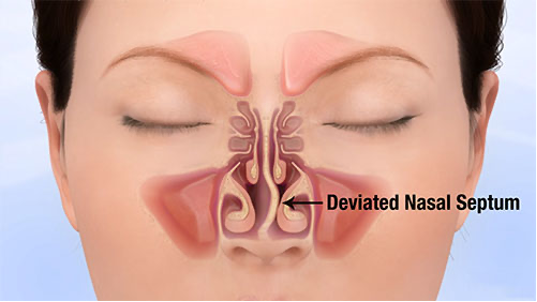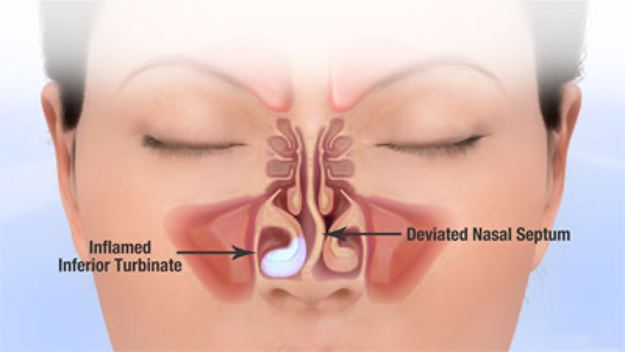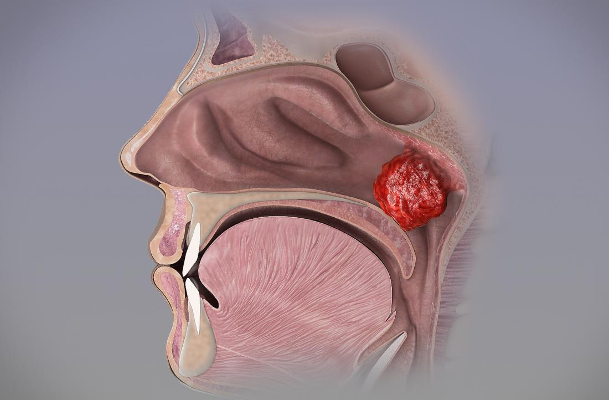Did you know that many people suffer from blocked nose problems and have forgotten how to breathe clearly through their nose? The nose is the main breathing route for air to enter our lungs and we should not be breathing mainly through our mouth at rest or when asleep. Over time, this tends to feel “normal” but it certainly isn’t! Symptoms of persistent nasal congestion often lead on to breathing problems when asleep, causing disrupted poor sleep quality, which then in turn, goes on to affect your ability to work and study in the daytime. Studies looking at the impact of having a blocked nose on your quality of life consistently show poor quality of life scores in patients who continue to suffer from an untreated blocked nose problem.
As a top ENT specialist in Singapore, we see many patients whose nose may have become obstructed due to various reasons, most commonly:
- Deviated nasal septum
- Enlarged inferior turbinates (the “sausages” of the nose)
- Enlarged soft tissue at the back of the nose e.g. adenoids, rarely tumour
- Nasal polyps (benign growths inside the nose)
- Sinus infections
- Anatomical variants eg concha bullosa
A. Deviated Nasal Septum
So what is a deviated nasal septum? This is a structural problem where the nasal bones and cartilage which form the support pillars of the nose inside, are bent and crooked, to lead to narrowing of the nasal passages (see Figure 1 below). This doesn’t leave much room for any further soft tissue swelling to occur e.g. during a bad cold, allergy flareups, sinus infections.

Figure 1: Deviated nasal septum with curved surface towards the patient’s left side, making the left nasal passage much narrower than the right side.
Medications, whether oral or topical sprays, don’t usually help nasal obstruction related to a deviated nasal septum. Surgery in the form of a septoplasty, would usually be the way to correct this septal deviation condition by making a small incision inside the nasal passage and removing the crooked spur of bone or cartilage creating the septal deviation. This procedure is done under a short general anaesthesia with the patient asleep and may be undertaken as day surgery or with a short stay in hospital overnight. Nasal sponges are inserted into the nose as packing usually just overnight and removed the next day before the patient goes home.
B. Enlarged Inferior Turbinates
Another very common cause of a persistently blocked nose is swelling of the inferior turbinates, the “sausages” of the nose which usually have an important job to warm and humidify the air entering the nasal passages (Figure 2). These long structures tend to become swollen and congested if your nose is rather sensitive or if you have an underlying nasal allergy (rhinitis). They also become enlarged in sinus infections, or when you fall ill with a bad cold or a bout of the flu.
Medications such as oral or topical decongestants, antihistamines and nasal sprays, can reduce the size of these swollen structures to help you breathe better but they do tend to be temporary measures. For some patients where medications fail to control their turbinate swelling or when medications have somehow stopped being beneficial, then a minor surgical procedure to reduce the size of the enlarged inferior turbinates may be a suitable option, called “turbinoplasties”.
Turbinoplasties are performed in many ways, depending on surgeon technique and experience, but commonly use coblation or some other low heat technique, to shrink swollen soft tissue through controlled scarring inside each “sausage”. Outfracture of the turbinate bone is also performed at the same time to further reduce the turbinates and increase the width of the nasal passage to help patients breathe more clearly. Again, turbinate procedures may be done as a day case under a short general anaesthesia but may also be undertaken as an overnight stay. Turbinate reduction is often performed together with a septoplasty to maximise the opportunity to increase the size of the nasal passages inside.

Figure 2: One common reason for a blocked nose is the swelling of the inferior turbinates inside the nose, the “sausages” of the nose, usually due to nasal allergy, sinus infection or some other form of nasal irritation e.g. smoking.
C. Enlarged Soft Tissue At The Back Of The Nose
Sometimes, we find excess soft tissue at the back of some noses and this soft tissue is called the adenoids (Figure 3). Adenoid tissue is a type of specialized lymph gland tissue, just like the tonsils, and they normally tend to be enlarged in the young child. If the adenoids grow too big, then they can obstruct the airflow through the back of the nose to cause snoring and difficulty breathing, especially when asleep. They are regarded as reactive soft tissue and are often enlarged if there is underlying allergic rhinitis or nasal allergies causing chronic inflammation of the adenoids.
We usually treat with medications first but if the adenoids persist in causing breathing difficulties, then an adenoidectomy is performed as a day case under a short general anaesthesia, to clear the excess adenoid tissue. There should not be any negative impact in the immune system when adenoids are removed in the adult and older child. Having an adenoidectomy done is usually a short minor procedure with fast recovery time and minimal discomfort.
Of course, when we find enlarged soft tissue growing at the back of an adult’s nose, we always bear in mind that we may sometimes need to rule out any underlying soft tissue tumour e.g. Nasopharyngeal cancer (NPC). NPC is the eighth most common cancer in Singapore, with a much higher incidence reported in Chinese males and smokers. If there is any clinical suspicion, then a biopsy of the back of the nose will be undertaken in clinic under local anaesthesia (where a nasal spray is used to numb the nose before the biopsy is done).

Figure 3: The adenoids are a lump of lymph gland tissue which grow at the back of the nose in children and adults. They should normally start to shrink naturally from the age of 5 onwards but they persist in some teenagers and adults to block the nose and cause breathing problems and snoring issues. In the adult with enlarged soft tissue at the back of the nose, the possibility of a nasal tumour should always be kept in mind.
So there you have it, the top 3 most common reasons why people suffer from a blocked nose and have breathing problems in Singapore writes Dr. Annabelle Leong. Remember that breathing through your mouth all the time is abnormal, because only your nose is designed to be the main route of entry for airflow into your lungs. If you persistently suffer dry mouth and throat discomfort upon waking up in the morning, or feel tired despite a good night’s sleep, your blocked nose needs to be properly checked out. The presence of nasal obstruction often makes any underlying obstructive sleep apnea much worse too. Top ENT specialists in Singapore can help you breathe much better through your nose and by doing so, help you sleep better and feel better too during the daytime. Breathe well, sleep well, live well!
Laila Azzahra is a professional writer and blogger that loves to write about technology, business, entertainment, science, and health.
